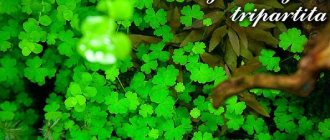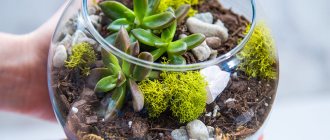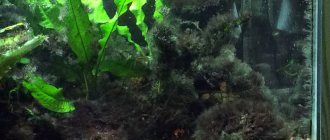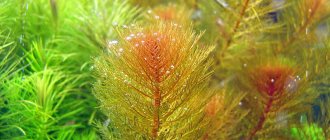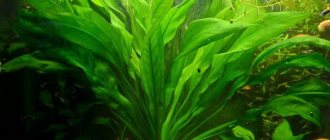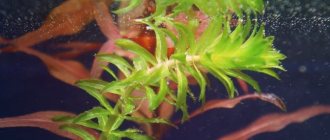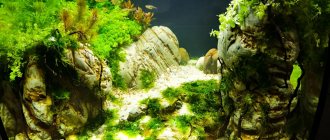Cottonwort (Hydrocotyle) is a herbaceous plant whose habitat is freshwater bodies. A bright representative of the Araliev family. Its homeland is considered to be the tropical regions of South America, where it feels most comfortable in stagnant, flowing waters. The culture can develop intensively in wetlands and in water. In botany, the plant is also known as “white-headed hydrocotyla”, “white-headed shieldwort”. Frequently, stinkwort is a perennial plant; annual representatives of this genus are less common.
Description
This plant is native to tropical waters in South America. It itself is quite unpretentious, but it takes root best in stagnant waters. It grows especially strongly in areas where there is silt and organic matter at the bottom.
Visually, the hydrocotila looks quite attractive. It has delicate stems that reach a height of up to 50 cm. The leaf is round, quite large, up to 4 cm in diameter. All parts of the bush have a green color. Some varieties have a brighter, light green color. The stem can grow in two ways. The first is upright growing, when the plant protrudes directly from the water. The second is creeping, in which it spreads along the bottom.
The leaves are attached to the stem using petioles. They can be either round or divided into lobes, interconnected in the center. In some species, the foliage has jagged edges.
Compatibility with other aquarium inhabitants
Hydrocotyl tripartita is suitable for keeping with most plants. But it is important to consider that, occupying a large area, it can obscure the light of other representatives of the underwater flora and itself suffer from such a deficiency from tall aquacultures.
Shield leaves get along best with small plants:
- cryptocoryne;
- aponogeton curly;
- horn fern;
- Ammania Senegalese;
- common cabomba.
Aquatic plants are not recommended for keeping together, as they can completely shade the aquarium.
Cottonweed is a non-toxic plant and does not pose any threat to aquarium animals. But not every neighborhood will be favorable for aquaculture itself.
| Compatible | Incompatible |
| Predatory fish | Goldfish |
| Angelfish | Soma |
| Viviparous: mollies, guppies, platies | Cichlids: African and Malawian |
| Crops: medium-sized barbs, labeo, zebrafish | Large barbs |
| Labyrinthine | Characinaceae |
| Parrot | Anostomaceae |
The undesirable proximity is due to the fact that phytophages will eat the delicate shield leaf. Other families from the presented group can also damage the plant.
Hydrocotyla - non-poisonous greens
Content
Hydrocotyla in an aquarium will not cause any problems, since it is unpretentious and will easily take root both in a small container and a large artificial reservoir. All she needs for active growth is:
Water parameters . The main condition for hydrocotyle is compliance with the temperature regime. In nature, it is found in tropical climates, so it therefore needs warm water. The optimal parameter is 18-28 degrees. At excessively low temperatures, growth stops and the bush itself may die. As for hardness and acidity, they do not matter. It is also advisable to periodically change the water. This will reduce the concentration of nitrates and phosphates, and will also give the plant an impetus for growth;
Lighting . It should be bright, since the shieldwort is accustomed to the bright tropical Sun. It is desirable that the intensity be at least 0.5 W/l. In poor lighting, the leaves become smaller and the stems gradually begin to die. As for the type of lamp, LEDs or fluorescent lamps work well. They provide a wide color range and do not emit heat, which will have a positive effect on the growth rate of the plant;
Soil . It also doesn't really matter. You can choose either sand or gravel as a substrate. You can also choose basalt, quartz, granite, etc. The fraction is also secondary, but fine soil is better because it will be easier to plant plants in it;
Feeding . Today, many aquarists use fertilizers to speed up the growth of plants in the aquarium. However, the shield leaf does not need UDO, since it has enough nutrients that are formed naturally.
We recommend reading the article: Japanese Blixa: maintenance and care
Hydrocotyla white-headed
White-headed hydrocotyla or white-headed shieldfoil photo
white-headed hydrocotyla
White-headed hydrocotyle (Hydrocotyle leucocephala) or white-headed shieldwort is widely distributed in nature in standing and flowing water bodies of tropical regions of South America. It is an original long-stemmed amphibian plant with round leaves of light green color up to 4 cm in diameter. The plant reaches a height of 50 cm. White-headed shieldwort is a relatively unpretentious and fast-growing plant.
White-headed hydrocotyla or white-headed stinkhorn photo
Hydrocotyla planted in the background of the aquarium looks very attractive. A plant planted in the ground quickly reaches the surface of the water and spreads along it, shading the bottom of the aquarium. To ensure that the rest of the aquarium vegetation does not suffer from a lack of lighting, the resulting clouds of hydrocotyls must be periodically thinned out. Hydrocotyla can not be rooted into the ground and can be used as a floating plant. In this case, it serves as a good refuge for fry. Hydrocotyla white-headed can be kept in both underwater and above-water form.
White-headed hydrocotyla or white-headed stinkhorn photo
Hydrocotyla white-headed in the paludarium photo
The white-headed hydrocotyla or white-headed stinkhorn does not have any special requirements for the conditions of keeping it. The optimal water temperature is 23-26 °C. At lower temperatures, plant growth stops. Hardness and active reaction of water do not play a significant role. The plant thrives in both acidic and alkaline environments. Recommended pH parameters 6-8. It is advisable to regularly replace the water with fresh water. Hydrocotyla white-headed has increased requirements for lighting conditions. Even with slight shading, the plant begins to decrease in size and degrades. The recommended lighting power for this hydrocoil is from 40 Lm/l. Daylight hours should be ~8-12 hours, depending on light intensity.
White-headed hydrocotyla or white-headed stinkhorn photo
Hydrocotyla white-headed propagates by cuttings. If good conditions are created, a young plant can be obtained even from a small piece of stem with one leaf.
Cool videos about plants from FanFishki
Subscribe to our YouTube channel so you don't miss anything
PRACTICAL NOTE ON GROWING AQUARIUM PLANTS
This note is posted in all FanFishka articles dedicated to aquarium plants. This is a cheat sheet with a link that will help you grow any aquarium plant and herbalist of any complexity.
Most of the reference materials are located in the Aquascape , we also recommend our brochure: Aquarium navigator for beginners: “Underwater Gardens of Babylon” .
The formula for success in growing plants can be depicted as follows.
First of all, the proper level of lighting is necessary.
(light intensity - Lumens)
Next, the proper concentration of CO2
Further macro-fertilizers and micro-fertilizers
Water parameters, care and quality water changes
The gradation of this formula is based on the degree of importance. Lighting intensity is primary, and then descending. Therefore, if your plants have holes in the leaves, they have sciatica (crooked) or there are problems with algae, then please do not read the “bad advice” - this is chlorosis (lack of iron), this is a lack of potassium... diarrhea, phimosis and endometriosis )
You always need to solve the problem of setting up an herbalist from major to minor. Plants will die more quickly from a lack of lighting than from a lack of Fe and K. Moreover, the latter are always present in one degree or another in the aquarium, but it is difficult to measure their precise value.
Below, let's go from the main to the minor.
Lighting in an aquarium with plants . Remember, the most important thing in light is its intensity (Lumens)! All other lighting characteristics: spectrum, Kelvin, PAR/PAR, Ra... are important, but secondary. There will be no intensity of lighting, there will be nothing. At the same time, the lighting intensity must be balanced - selected specifically for your project (height of the water column, number and types of plants, daylight hours).
Based on the above, choose aquarium lighting primarily by the number of lumens, and then everything else.
Lighting is the most expensive part. The most budget-friendly solution is to install ordinary construction-street floodlights above the aquarium . Fortunately, they are now very thin and aesthetic. And believe me, under them everything grows with a bang, of course, provided that all the other components are present.
In order not to be unfounded, here are photos of our herbalists, which were grown exclusively under LED spotlights or with their presence.
If you want professional lighting or aesthetics. Then you will have to fork out some money. The amounts can vary quickly from 10,000 to 50,000+ rubles for a 100 liter aquarium. For example, in 2021 we switched to professional lighting - ISTA Titan . Yes, not cheap, but the lamps are Achon! We have grown a professional competitive aquascape under them. That’s why we advise you to pay attention to them.
Well, it’s difficult to advise anything, because... Everyone has different needs and capabilities. In this article we talk about the products of our partners - Tetra , Laguna , ISTA lighting .
We tried to briefly and objectively talk about them. Then it's up to you. In any case, we do not really recommend that you pay attention to handicraft lighting assembly from folk craftsmen. Not all, but as a rule, they shove who knows what kind of diodes into such an assembly, assemble it all on their knees... and believe me, more than once on the forum you hear echoes of the consequences of such a purchase. After all, a company is a company. At a minimum, you are given warranty and post-warranty service.
If you are a beginner, your first herbalist, then LED spotlights are your choice. Let's move on, otherwise this note isn't very short =)
CO2 for aquarium plants . The plant is approximately 90% water, the remaining 10% is dry matter. Of that 10%, 46% is carbon. This is why CO2 supply is so important in a planted aquarium.
Plants in an aquarium obtain carbon “from water” - from carbon-containing compounds. But the natural concentration of C-carbon in water is small and is only sufficient for unpretentious plants, but they, and even more so, will be happy with additional carbon feeding. The supply of CO2 can be provided using mash or a CO2 balloon system , lemon juice or other methods.
The best, professional, simple and budget option is to supply carbon dioxide through a cylinder. One thing, however, is the initial purchase of a set: a cylinder, an MG valve, a diffuser…. will hit the budget.
Is it possible to do without CO2, but for a couple of bushes of simple plants ( cryptocorynes , echinodorus , most ludwigias , etc.).
What balloon systems can you recommend? The most budget option is an assembly from craftsmen who sell CO2 systems in VK and on forums. Everything is very high quality.
If you want a branded item, then we recommend the most inexpensive and at the same time high-quality CO2 systems from ISTA (Taiwan) . We have been using them for 5 years and recommend them to you.
On sale you will find two series of ISTA Aluminum CO2 Cylinder cylinders, with horizontal and vertical threads of 1 and 3 liters.
Fertilizers for an aquarium with plants . All fertilizers, of any brand, can be divided into MACRO-FERTILIZERS and MICRO-FERTILIZERS .
Macro fertilizers are nitrate NO3 and phosphate PO4 from which plants take N-nitrogen and P-phosphorus. These are the most important elements after CO2 - C-carbon.
Remember - Redfield's proportion rules . Always keep it under control and everything will be ok. Right, based on our observations, Redfield’s proportion rules only in full NPC proportions. Incomplete proportion - without carbon C does not give good results.
Micro fertilizers . These are all the other less important elements that are necessary for plants (see link). There is no point in putting too much emphasis on them. Firstly, all of them are contained in one quantity or another in tap water and are restored in the aquarium with changes. Secondly, an overdose of micro very quickly leads to an outbreak of algae.
A common mistake made by beginners is not understanding what they are pouring into the aquarium. For example, let's take such a popular and popular fertilizer as Tetra PlantaMin . Read the product summary at the link - it strengthens, stimulates, and gives a chic body shape.
A beginner, without delving into the essence, uses it and gets an outbreak of algae, writes on the forums - “Like, wow, what a bad Tetra.” And the trouble lies not in the drug, but in a lack of understanding of the nitrogen cycle and balance in the herbalist . The beginner has a Redfield bias (let’s say N and P are generally zero) and instead of making up for the lack of these primary elements, he fills the aquarium with Tetra PlantaMin - a micro-fertilizer (iron, potassium, manganese). As a result, going over the micro is only detrimental, because... plants lack the base - nitrogen and phosphorus.
Thus, you must understand what plants lack and understand fertilizers.
How to understand what plants lack? It's simple. Now the market is filled with a variety of expensive and not so expensive aquarium water tests. We recommend inexpensive domestic ones - VladOx drop tests , they are sold online and offline.
We also recommend, let’s not be afraid of this word, innovative domestic UHE tests . They are currently only sold online.
The minimum set of tests for an herbalist is NO3 and PO4. It is advisable to have the entire nitrogen range: NH4, NO2, NO3. As well as kH and pH tests.
Tests help us monitor the situation in the herbalist, but over time it is advisable to learn to see and feel the aquarium for yourself. With experience you need to move away from “convulsive testing”; the best aquarium test and tool is ourselves.
Let's summarize this part. Macro, it’s macro in Africa too. The link above generally contains a recipe on how to make them yourself. If you are not yet ready for self-mixing, then always and everywhere you will find a line of fertilizers from Tetra: Tetra Planta Macro , Tetra PlantaMicro , substrates, root tablets and much more .
Of course, there are many other brands that produce aquarium fertilizers. There is an opportunity, use even ADA products. All markers are different in taste and color. The main thing is to use it with a clear understanding of what you are using it for and what you want to get in the end.
From the professional line of fertilizers, at an adequate price, we can recommend Prodibo (soils, soils, macro, micro, stimulants, etc.).
So, something like a note turns into the Talmud. Which is not surprising - the topic is very broad. One moment left.
Water parameters for aquarium plants. Link1 and Link2 , please look at these articles, they cover the essence quite well.
Here we note that the quality of photosynthesis is influenced by the process of caring for the aquarium: water parameters (kH, pH below 7), high-quality filtration and aeration, competent and timely water changes.
Please study
Reproduction and planting
This process is also not particularly complicated. Reproduction is carried out through cuttings. Under optimal conditions (mainly related to light intensity and daylight hours), the bush will produce a young shoot.
The aquarist can only wait until 5-6 leaves appear on it, after which the bush can be separated and planted. In general, hydrocotyla is so unpretentious that even an accidentally detached shoot with just 1 leaf can survive and grow. But, of course, it is advisable to let him get the maximum nutrients from the mother bush.
As for landing, it is not particularly difficult. Most lovers of underwater flora and fauna simply leave it in the water column. The shield leaf absorbs nutrients not through the roots, but through its surface as a whole. In fact, it only needs the root system to stay in the ground. Therefore, you should not bury the bush too much. It is enough to simply press it down lightly with a stone so that it does not float up. Then the stems and leaves will grow along the ground and form beautiful thickets.
Diseases and pests of shieldwort
The plant is susceptible to some diseases associated with improper care.
Diseases
A stop in the development and growth of exotics occurs due to a lack of carbon dioxide in the aquarium. This can also occur with a sharp change in the acid-base balance of the crop’s habitat.
Small holes may suddenly appear on the leaves of the green inhabitant of the underwater kingdom. Over time, the plate may even turn yellow and fall off. This suggests that the bush is sorely lacking nutrients: phosphorus and potassium. In this case, you will have to fertilize with a special complex.
ATTENTION. If the leaves on the bush begin to become smaller, stretch out and turn pale, then this indicates a lack of lighting.
If there is a conflict with environmental conditions, the hydrocotyl may completely wither. At the first sign of a problem, it is necessary to check the parameters of the chemical composition.
A white coating on the leaves appears due to a deficiency of carbon dioxide, they acquire a yellow or reddish tint due to a lack of sulfur and nitrogen, and yellowed tips indicate a serious lack of calcium.
Pests
We can say with confidence that hydrocotyl is not attacked by any insect pests. Even aquarium fish do not destroy it.
Kinds
Today there are many varieties of this plant. However, the following types are especially popular:
Tripartita
It is often classified as ground cover plants. Of course, it can provide good growth in the lower part of the aquarium. However, in its essence, the type of tripartite is not such. “Ground cover” is characterized by the fact that it sends out stems along the ground and takes root on its own. This hydrocoil does not cling to stones. Only those parts that are near it are buried in the substrate. The rest will strive for thicker water, because that’s where they feel best. This species differs from others in its miniature size. The leaves grow to only 1.5 cm. They are on a small stalk up to 3 cm;
White-headed
It has larger and rounded leaves. It can also either float around the aquarium or be rooted. Looks impressive towards the back of the aquascape. However, it is better not to plant it and leave it near the surface, where the plant will grow roots and the leaves will begin to emerge above the water, creating a thick floating carpet;
Benefits for the aquarium
In an aquarium, the shield leaf serves as an element of shelter for animals and shades the lighting. Small fish feel safe in such areas. Due to the bright color of the leaves and the peculiarities of vegetation, the main function of such a plant is decorative.
From hydrocotyle they form:
- beautiful lush thickets;
- ground cover areas;
- spherical figures;
- sparse bushes or lawns;
- focal points.
The plant is in the middle ground, but the variations for the arrangement of “emerald” bushes are not limited to this zone.
Plant cost
Trifid foxtail is sold in pet stores, in places where aquarium paraphernalia are sold, and on online trading platforms. The cost is different everywhere and depends on the degree of development of the plant and the pricing policy of the seller.
| Hydrocotyla tripartite | Average cost, in rubles |
| Cuttings | 100 |
| Small young bush | 150-220 |
| Mature overgrown plant | 250-500 |
Online stores carefully pack the plant and send it to the delivery region by transport companies.
You can purchase the plant at a regular pet store or in an online store.
Properties and Features
Hydrocotyla white-headed , or shieldwort , is a moisture-loving representative of the Umbelliferae family. The main characteristics are rapid growth and unpretentiousness to living conditions.
Hydrocotyla, growing to the water surface, spreads along it. It is used as a decorative element for aquariums and the shores of reservoirs. This is the so-called bright lawn on the surface of the water, which can protect fish from harmful lighting and shelter defenseless fry.
Subtleties of care
In nature, the white-headed shieldwort stands out among aquatic plants for its rapid growth and unpretentiousness. However, when growing in an aquarium, it is advisable to provide it with conditions close to natural:
- Water environment. The water temperature for the plant is 22-28 degrees. In cooler water, stinkwort will not grow. Acidity and hardness parameters do not affect hydrocotyle, but constant replacement of water with fresh water is required. When stagnant, the plant begins to wither and may die.
- Priming. The white-headed shieldwort feels great on the water surface. If desired, you can lower part of the plant to the bottom using heavy stones or driftwood. If planting is required, choose a substrate for the paludarium. It can be purchased at a specialty store. Coarse sand will also work. No adaptation is required during transplantation.
- Mineral supplements. The plant receives all the necessary substances directly from the water, so the fertilizer is diluted and added to the aquarium. When grown on the ground, fertilizer is also given in liquid form. The plant needs iron to maintain its natural color. A deficiency of the substance will manifest itself as yellowing of the edges of the leaves and slower growth.
- Lighting. It is not recommended to keep white-headed stinkhorn in shaded conditions. The plant requires 12 hours of light per day. Do not place the aquarium in direct sunlight to avoid the leaves getting burned. Install artificial lighting. It is better to combine a fluorescent and incandescent lamp.
